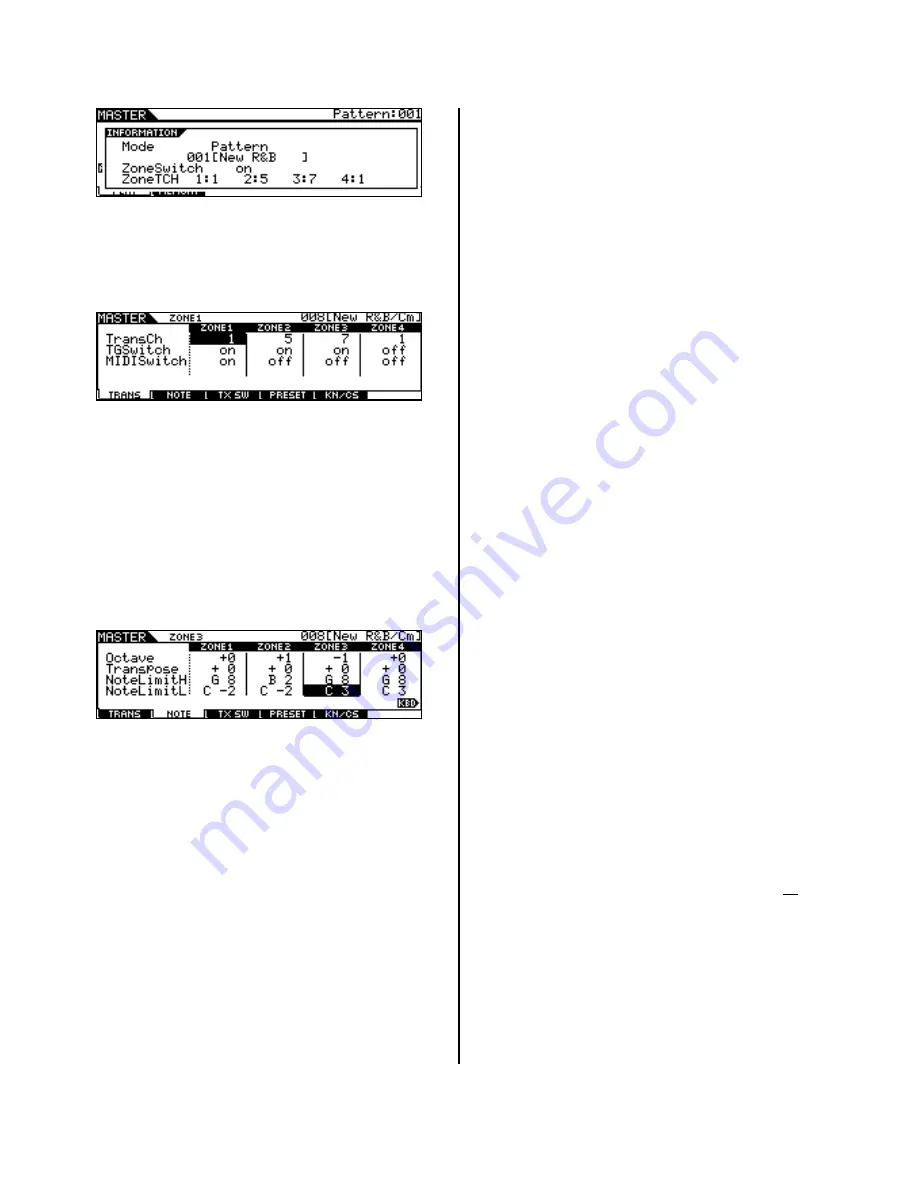
In the above screen shot of MASTER 008 it is
associated with a PATTERN, Pattern :001. There
are actually 3 ZONES active allowing you to play
three sounds at once on top of this Pattern. Check
it out:
Notice that TG Switch is active for the first 3
Zones – by using this MASTER setup to recall the
New R&B Pattern you can actually select 3
different PARTS and play them Live on top. As you
can see MIDI channel 1, 5 and 7 are active
internally. Letting you play strings (under
arpeggio control), Guitar and Pizzacato strings at
once. If you simply recall the Pattern (from
Pattern Mode) you could only play one PART at a
time. Master mode is giving the ability to address
three Parts via the Zone setup. These Parts are
NOTE LIMITED by the Master Zone setup:
Designing your own setups
How complex can these setups get? This is
unknown. If you have a need, you’ll figure it out,
necessity being the mother of invention. The thing
is; if you understand the fundamental rules, you
will know the difference between what is and what
is not possible. For example, if you play in a live
scenario, you may need to play more than one
keyboard at sometime during the madness of an
evening’s set. Can you recall a Master setup on
the Motif ES that sends setup data to your other
devices and play an internal/external combination
when you are playing on the Motif ES’s keybed
and play a different sound from the Motif ES when
you move to a second external keybed? Well, yes,
that is possible. If you have a Master Zone setup
that is associated with a MIX, you can certainly
play a 4-Zone setup with as many as four
internal/external sounds and still access the Motif
ES sound set, independently, via the MIDI IN
jack. Because the Motif ES is multi-timbral and
capable of receiving on multiple MIDI channels
when in a SONG or PATTERN MIX, you will be able
to control a PART or PARTS of that MIX via MIDI
IN. Imagine that your second keyboard when set
to transmit on MIDI channel #16 communicates
with PART 16 of the Motif ES’s MIX. At the same
time you can independently be transmitting via a
ZONE MASTER to 4 separate PARTS when you
play the Motif ES’s keyboard (let’s say on
channels 1-4). If you send Program Changes from
your external keyboard on any unused MIDI
channel (5-16) you can select and change the
sounds in the Motif ES’s MIX remotely. If that
external keyboard can send Bank Select and
Program Changes you can select VOICES from the
entire Motif ES palette. No one article can outline
all the possibilities. But if you understand MIDI
and you understand how the Motif ES behaves in
response to your MIDI settings you will be able to
design some pretty complex but thoroughly useful
setups. This article can only hope to get you
started.
Storage issues
Your MASTER setups will be saved as part of an
“ALL” data FILE type. Master setups will remain in
memory after power down but will be cleared if
you perform a Factory Reset. Backup all data by
saving an “ALL” file type to an optional
SmartMedia card or USB drive. The data that they
“point” to must be returned to its appropriate
place, i.e., Voice data, Performance data,
Song/Pattern. If you change or replace any of the
target data, then the MASTER setups will be
altered. The MASTER actually stores ‘pointers’ not
the actual data. So a MASTER setup may be there
but the song, pattern or sound it is referencing
my not. For example, if your MASTER setup
targets a USER bank Voice, if you do not have
that USER Voice in the proper location, the data
for the MASTER will be incorrect. It will simply
target the Voice in that location. If the MASTER is
associated with a SONG MEMORY location and the
song data is not loaded into that location, the
MASTER will point to the location but the data will
not be there. For this reason Master’s cannot be
loaded individually – they depend on all the
components being in the proper places, because
all a Master is, is a collection of pointers. To
restore your MASTER setups you would need to
restore ALL data.
Phil Clendeninn
Technology Products
©Yamaha Corporation of America
8



















